Tissue Banking Market Size
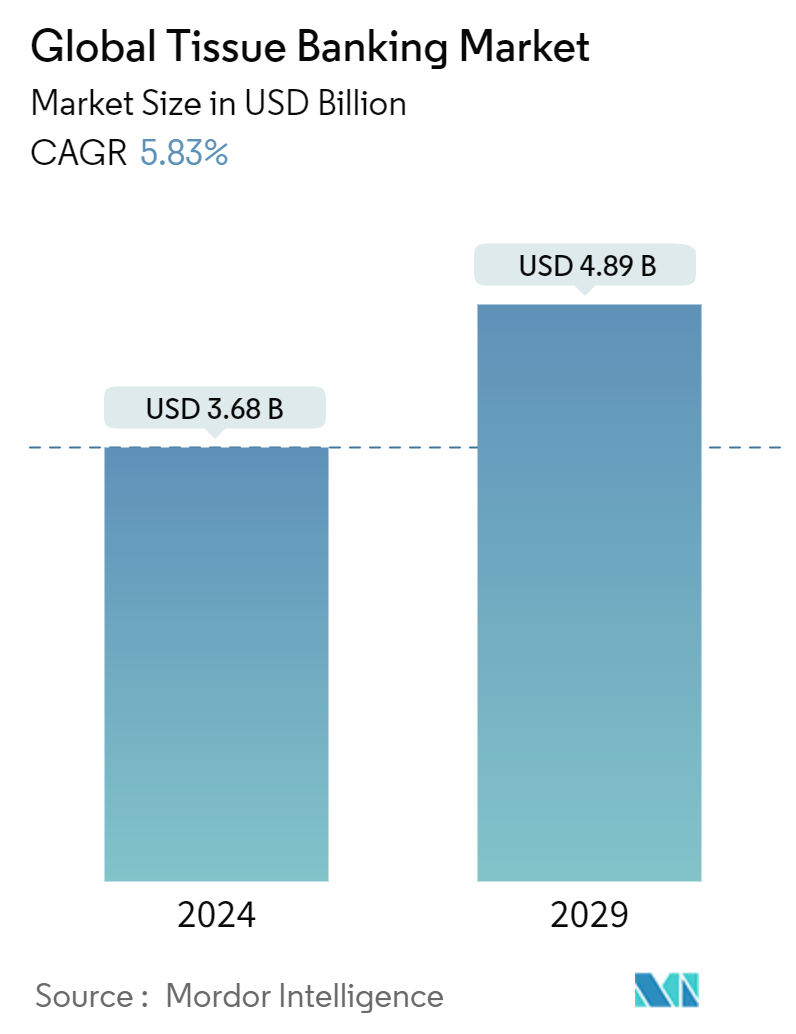
| Study Period | 2019 - 2029 |
| Market Size (2024) | USD 3.68 Billion |
| Market Size (2029) | USD 4.89 Billion |
| CAGR (2024 - 2029) | 5.83 % |
| Fastest Growing Market | Asia Pacific |
| Largest Market | North America |
Major Players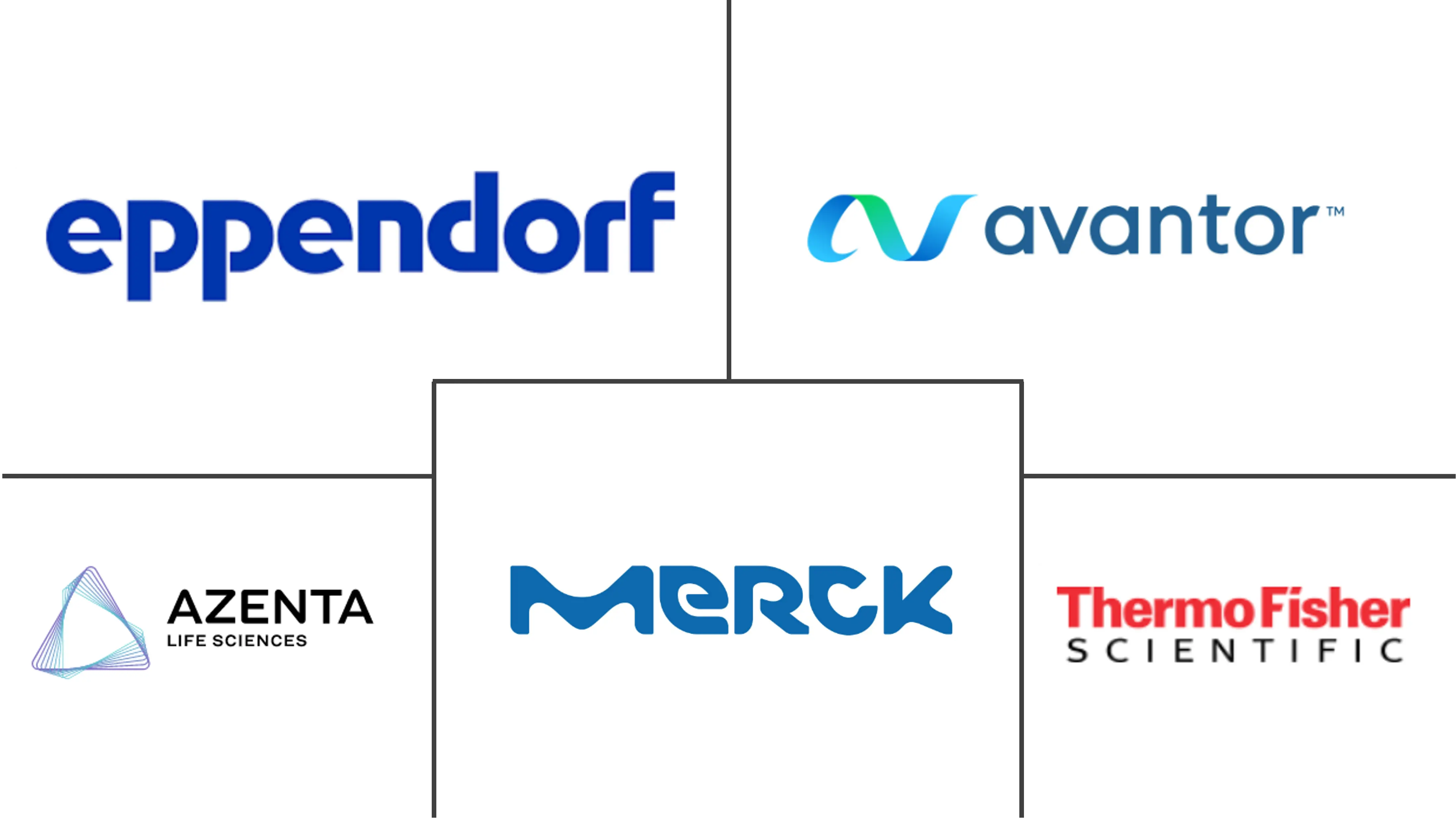
*Disclaimer: Major Players sorted in no particular order |
Tissue Banking Market Analysis
The Global Tissue Banking Market size is estimated at USD 3.68 billion in 2024, and is expected to reach USD 4.89 billion by 2029, growing at a CAGR of 5.83% during the forecast period (2024-2029).
The sudden emergence of COVID-19 had a significant impact on the market studied. According to various research studies, tissue distribution has been greatly reduced because of the decrease in surgical activity in the initial days of the COVID-19 pandemic. It was also reported that during the very initial period, a general drop in the number of tissue donors had been observed in various countries globally. Due to the cancellation of elective operations, there was a scarcity of tissues, and the available tissues were only utilized in urgent surgical interventions or medical procedures. These impacted the studied market adversely.
However, during the later pandemic, the trend for stem cell research increased to find effective vaccines for COVID-19 infection. For instance, according to a research article published in the Stem Cell Research and Therapy journal in January 2022, cell therapy is a significant treatment applied in several diseases, including lung, cardiovascular, liver, kidney, and other diseases. Thus these are anticipated to find a cure for COVID-19. Also, as per the source above, stem cell therapy and stem cell-derived organoid models received huge attention as a new treatment and research method for COVID-19. Therefore, such instances indicate that the pandemic had a considerable impact on the market growth, and it is expected to continue its growth over the forecast period.
The rising healthcare expenditure, the growing burden of chronic diseases, and technological advances in drug discovery and development are the major drivers for the tissue banking market. For instance, according to September 2022 update by WHO, chronic diseases have always been a massive global challenge, and they accounted for approximately 74% of all deaths worldwide in 2021. Furthermore, according to the September 2021 update by IDF, around 537.0 million adults (20-79 years) were living with diabetes in 2021, and around 643 million and 783 million people are expected to live with diabetes by 2030 and 2045, respectively.
In addition, as per the Global Cancer Observatory data updated in March 2021, nearly 19.3 million new cases of cancer were diagnosed in 2020 globally among both men and women. The same source reported that the incidence of cancer was growing at a rapid pace in the world and estimated that the number of new cases of cancer in both sexes is projected to reach around 30.2 million by 2040. Thus, with the increasing number of chronic diseases, the demand for tissue banks is anticipated to increase as tissues are generally used in research activities related to diseases and the diagnosis and treatment of diseases. Therefore, such factors are anticipated to propel the tissue banking market growth over the forecast period.
However, a stringent regulatory scenario is expected to hinder market growth over the forecast period.
Tissue Banking Market Trends
Medical Research Segment is Expected to Witness Growth Over the Forecast Period
Medical research using tissues generally helps to expand knowledge regarding human biology and helps to develop disease diagnosis techniques, future therapies, and treatment protocols. In addition, conducting research using tissues enables the faster development of more effective, safer drugs and a better understanding of the underlying disease processes that affect humans. Human tissues are the most effective tissues for medical research. They are typically obtained from post-mortem of people who are organ donors, as leftovers from surgery, and through blood or other body fluids. Thus, owing to the increase in the medical research segment, growth is expected over the analysis period.
The increasing use of tissues and the wide applicability of tissues in medical research is one of the key drivers for segment growth. For instance, according to an article published by the Physicians Committee for Responsible Medicine in May 2022, the use of human tissues in scientific research has improved health care by leading to discoveries in disease progression, drug development, and medical procedures. Organs on chips, 3D bioprinting, and other methods that use human tissue instead of animals provide results that translate better to human health.
The source above also reported that human tissues are currently used in many areas of biomedical research, including research on conditions and diseases such as cancer, heart disease, diabetes, Alzheimer's disease, and other dementias, and for the treatment of conditions such as Parkinson's disease and multiple sclerosis. Human tissue is also used in microfluidic systems for toxicology testing and as biosensors for detecting biological or chemical hazards. Thus, owing to the upsurge in medical research, the demand for tissue banking is increasing. This is further expected to fuel the segment's growth.
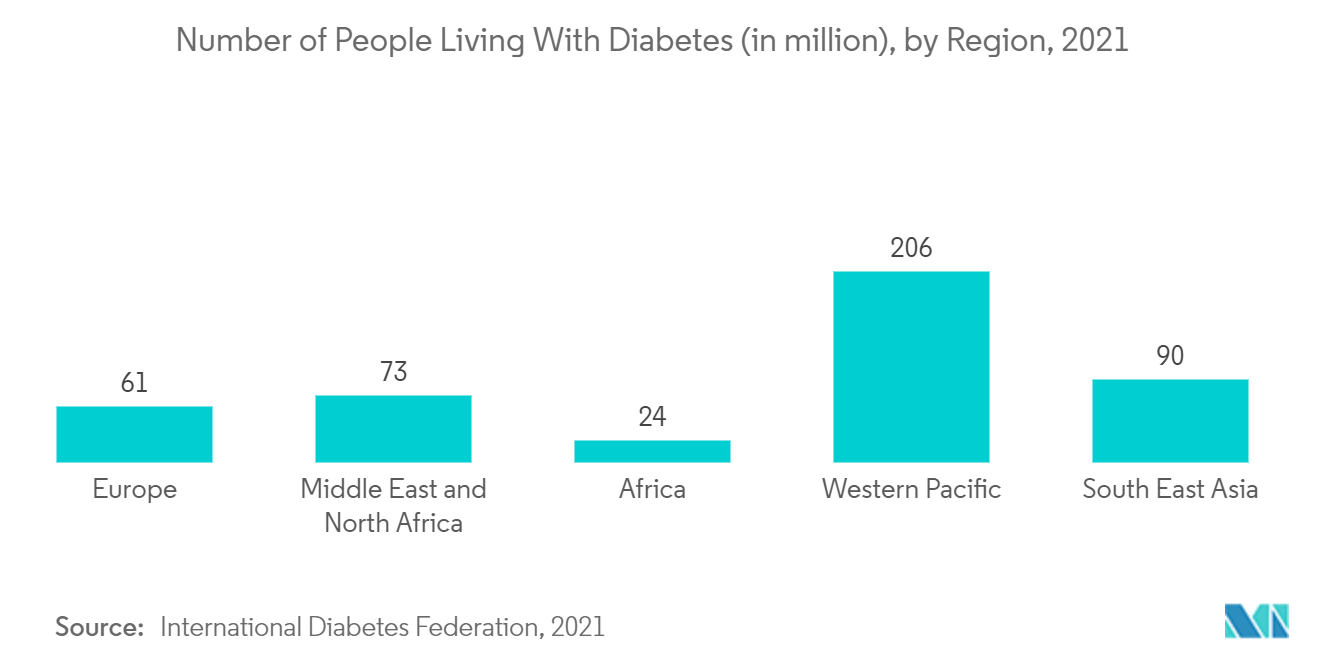
North America is Expected to Hold a Significant Share of the Market
North America is expected to dominate the overall tissue banking market over the forecast period. The growth is due to factors such as increasing research activities, a rise in chronic diseases, and an increasing number of pharmaceutical companies in the North American region.
As tissue banks provide donor screening, recovery, processing, storage, and/or distribution of allograft tissue, the increasing prevalence of heart diseases among chronic diseases is creating demand for tissue banks in the United States. According to the July 2022 update by CDC, heart disease is common among the population of the United States, and coronary heart disease was the most common type of heart disease which affected nearly 20.1 million adults aged 20 or above in 2020.
In addition, according to the report published by the Government of Canada in August 2021, more than 3.0 million Canadians, or 8.8% of the population were diagnosed with diabetes in 2020, and 6.1% of Canadian adults are at high risk of developing diabetes in the upcoming years. It also reported that the increasing prevalence of diabetes in Canada and the negative impacts of COVID-19 on people with diabetes have underscored the importance of continued investment in diabetes research, treatment, and prevention. Therefore, such a scenario is expected to propel market growth in North America.
Key product launches, high concentration of market players or manufacturers, acquisitions, and partnerships among major players are among the factors driving the growth of the tissue banking market in the country. Additionally, government organizations are heavily investing in various tissue-banking projects, which is further fueling the market growth.
For instance, in October 2021, the National Human Genome Research Institute planned to expand existing gene expression resources to include developmental tissues by awarding USD 38.5 million over five years to the Developmental Genotype-Tissue Expression (dGTEx) project. This project aims to build a widely available tissue bank and database with information about human developmental gene expression in many types of tissues from children for use in basic and clinical research in the United States. Such investments are expected to contribute to the overall, market growth in the region. Therefore, owing to increasing investments and the prevalence of various diseases, the studied market is anticipated to witness growth in North America.
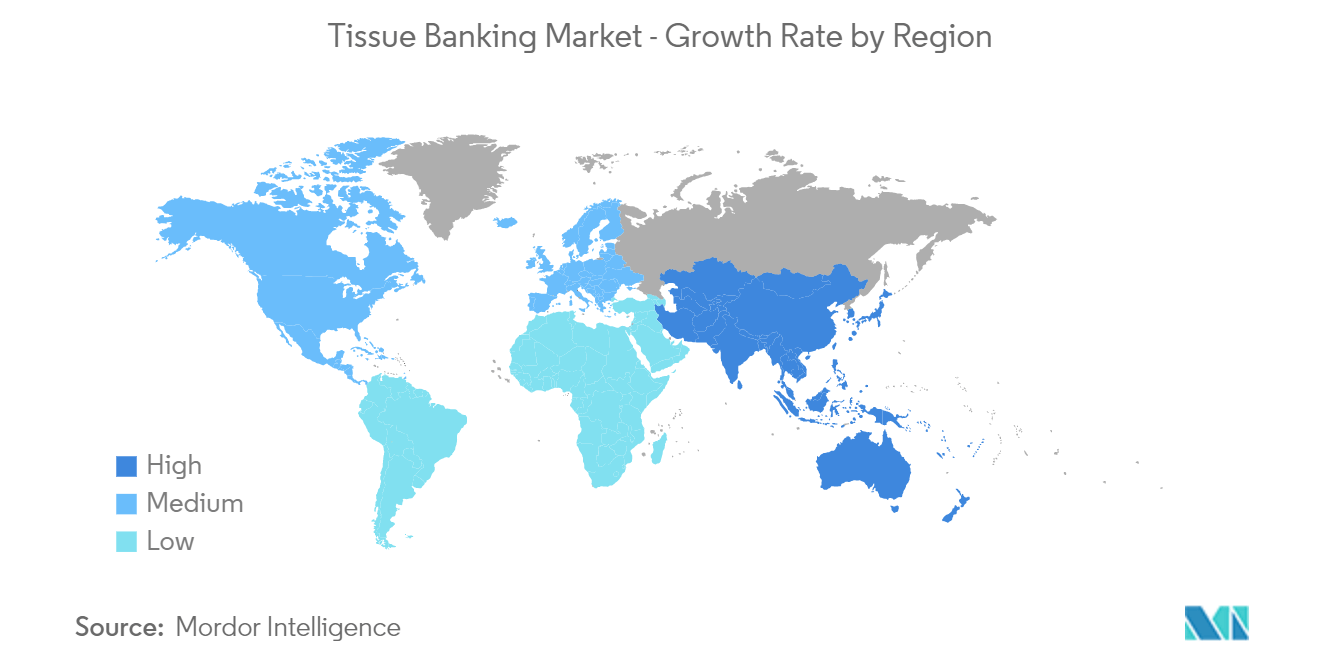
Tissue Banking Industry Overview
The tissue banking market is competitive in nature and consists of various global and regional market players. The competitive landscape includes an analysis of a few international as well as local companies which hold the market shares and are well known, including AMS Biotechnology (Europe) Limited, Avantor, Inc (VWR International), BioCision LLC, Brooks Automation, Custom Biogenic Systems, Eppendorf AG, Hamilton Company, Merck KGaA, and Thermo Fisher Scientific, Inc. among others.
Tissue Banking Market Leaders
-
Avantor, Inc.
-
Merck KGaA
-
Thermo Fisher Scientific, Inc.
-
Eppendorf AG
-
Azenta Life Sciences
*Disclaimer: Major Players sorted in no particular order
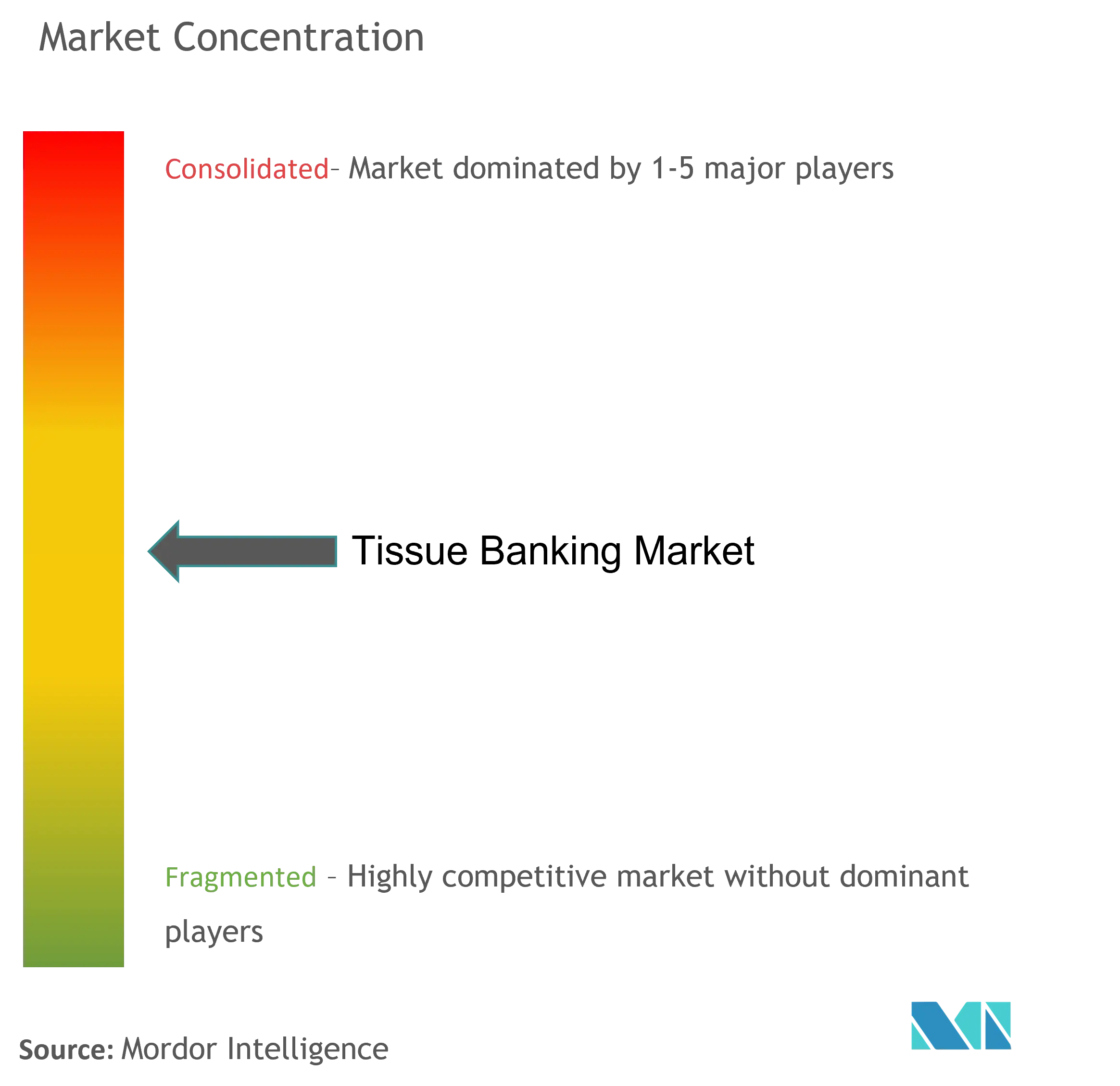
Tissue Banking Market News
- November 2022: the Department of Health (DoH), Abu Dhabi, the regulator of the healthcare sector in the United Arab Emirate, and United States-based Eversight, one of the non-profit eye banks in the world, partnered to establish the country's first Eye and Tissue Bank.
- June 2022: LifeLink Tissue Bank launched the Birth Tissue Donation Program, the first of its kind in the Tampa Bay area, in partnership with Tampa General Hospital (TGH).
Tissue Banking Market Report - Table of Contents
1. INTRODUCTION
- 1.1 Study Assumptions and Market Defination
- 1.2 Scope of the Study
2. RESEARCH METHODOLOGY
3. EXECUTIVE SUMMARY
4. MARKET DYNAMICS
- 4.1 Market Overview
-
4.2 Market Drivers
- 4.2.1 Rising Healthcare Expenditure
- 4.2.2 Growing Burden of Chronic Diseases
- 4.2.3 Technological Advances in Drug Discovery and Development
-
4.3 Market Restraints
- 4.3.1 Stringent Regulatory Scenario
-
4.4 Porter Five Forces
- 4.4.1 Threat of New Entrants
- 4.4.2 Bargaining Power of Buyers/Consumers
- 4.4.3 Bargaining Power of Suppliers
- 4.4.4 Threat of Substitute Products
- 4.4.5 Intensity of Competitive Rivalry
5. MARKET SEGMENTATION (Market Size by Value - USD Million)
-
5.1 By Product
- 5.1.1 Equipment
- 5.1.1.1 Cryopreservation Equipment
- 5.1.1.2 Thawing Equipment
- 5.1.1.3 Quality Control Equipment
- 5.1.1.4 Others
- 5.1.2 Media and Consumables
-
5.2 By Application
- 5.2.1 Therapeutics
- 5.2.2 Medical Research
- 5.2.3 Other Applications
-
5.3 Geography
- 5.3.1 North America
- 5.3.1.1 United States
- 5.3.1.2 Canada
- 5.3.1.3 Mexico
- 5.3.2 Europe
- 5.3.2.1 Germany
- 5.3.2.2 United Kingdom
- 5.3.2.3 France
- 5.3.2.4 Italy
- 5.3.2.5 Spain
- 5.3.2.6 Rest of Europe
- 5.3.3 Asia-Pacific
- 5.3.3.1 China
- 5.3.3.2 Japan
- 5.3.3.3 India
- 5.3.3.4 Australia
- 5.3.3.5 South Korea
- 5.3.3.6 Rest of Asia-Pacific
- 5.3.4 Middle East and Africa
- 5.3.4.1 GCC
- 5.3.4.2 South Africa
- 5.3.4.3 Rest of Middle East and Africa
- 5.3.5 South America
- 5.3.5.1 Brazil
- 5.3.5.2 Argentina
- 5.3.5.3 Rest of South America
6. COMPETITIVE LANDSCAPE
-
6.1 Company Profiles
- 6.1.1 Rokit Healthcare Inc.
- 6.1.2 AMS Biotechnology (Europe) Limited
- 6.1.3 Avantor, Inc (VWR International)
- 6.1.4 Sartorius AG
- 6.1.5 Azenta Life Sciences
- 6.1.6 Bio-Rad Laboratories Inc.
- 6.1.7 Eppendorf AG
- 6.1.8 Hamilton Company
- 6.1.9 Merck KGaA
- 6.1.10 Thermo Fisher Scientific, Inc.
- 6.1.11 LifeLink Tissue Bank
- 6.1.12 BioLife Solutions
- *List Not Exhaustive
7. MARKET OPPORTUNITIES AND FUTURE TRENDS
** Subject To AvailablityTissue Banking Industry Segmentation
As per the scope of the report, tissue banks facilitate the collection and banking of human tissues. These tissues play an important role in many applications associated with healthcare. The Tissue Banking Market is Segmented by Product (Equipment and Media and Consumables), Application (Therapeutics, Medical Research, and Other Applications), and Geography (North America, Europe, Asia-Pacific, Middle East and Africa, and South America). The market report also covers the estimated market sizes and trends for 17 different countries across major regions globally. The report offers the value (in USD million) for the above segments.
| By Product | Equipment | Cryopreservation Equipment |
| Thawing Equipment | ||
| Quality Control Equipment | ||
| Others | ||
| By Product | Media and Consumables | |
| By Application | Therapeutics | |
| Medical Research | ||
| Other Applications | ||
| Geography | North America | United States |
| Canada | ||
| Mexico | ||
| Geography | Europe | Germany |
| United Kingdom | ||
| France | ||
| Italy | ||
| Spain | ||
| Rest of Europe | ||
| Geography | Asia-Pacific | China |
| Japan | ||
| India | ||
| Australia | ||
| South Korea | ||
| Rest of Asia-Pacific | ||
| Geography | Middle East and Africa | GCC |
| South Africa | ||
| Rest of Middle East and Africa | ||
| Geography | South America | Brazil |
| Argentina | ||
| Rest of South America |
Tissue Banking Market Research FAQs
How big is the Global Tissue Banking Market?
The Global Tissue Banking Market size is expected to reach USD 3.68 billion in 2024 and grow at a CAGR of 5.83% to reach USD 4.89 billion by 2029.
What is the current Global Tissue Banking Market size?
In 2024, the Global Tissue Banking Market size is expected to reach USD 3.68 billion.
Who are the key players in Global Tissue Banking Market?
Avantor, Inc., Merck KGaA, Thermo Fisher Scientific, Inc., Eppendorf AG and Azenta Life Sciences are the major companies operating in the Global Tissue Banking Market.
Which is the fastest growing region in Global Tissue Banking Market?
Asia Pacific is estimated to grow at the highest CAGR over the forecast period (2024-2029).
Which region has the biggest share in Global Tissue Banking Market?
In 2024, the North America accounts for the largest market share in Global Tissue Banking Market.
What years does this Global Tissue Banking Market cover, and what was the market size in 2023?
In 2023, the Global Tissue Banking Market size was estimated at USD 3.47 billion. The report covers the Global Tissue Banking Market historical market size for years: 2019, 2020, 2021, 2022 and 2023. The report also forecasts the Global Tissue Banking Market size for years: 2024, 2025, 2026, 2027, 2028 and 2029.
Tissue Banking Industry Report
Statistics for the 2023 Tissue Banking market share, size and revenue growth rate, created by Mordor Intelligence™ Industry Reports. Tissue Banking analysis includes a market forecast outlook to 2029 and historical overview. Get a sample of this industry analysis as a free report PDF download.



